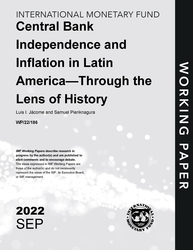
Central Bank Independence and Inflation in Latin America—Through the Lens of History
Central Bank Independence and Inflation in Latin America—Through the Lens of History
READ MORE...
Volume/Issue:
Volume 2022
Issue 186
Publication date: September 2022
ISBN: 9798400219030
$20.00
Add to Cart by clicking price of the language and format you'd like to purchase
Available Languages and Formats
| English |
Prices in red indicate formats that are not yet available but are forthcoming.
Topics covered in this book
This title contains information about the following subjects.
Click on a subject if you would like to see other titles with the same subjects.
Banks and Banking , Inflation , Economics- Macroeconomics , Money and Monetary Policy , Economics / General , Central Bank Independence , Inflation , Latin America , inflation episode , independence result , CBI index , gold exchange , finance government expenditure , inflation distribution , executive branch , fiscal dominance , country level , inflation expectation , term of office , credit to the government , inflation inertia , Latin American country , Central bank autonomy , Central bank legislation , Bank credit , Central bank organization , Central America , South America
Also of interest
Summary
We study the link between central bank independence and inflation by providing narrative and empiricial evidence based on Latin America’s experience over the past 100 years. We present a novel historical dataset of central bank independence for 17 Latin American countries and recount the rocky journey traveled by Latin America to achieve central bank independence and price stability. After their creation as independent institutions, central bank independence was eroded in the 1930s at the time of the Great Depression and following the abandonement of the gold exchange standard. Then, by the 1940s, central banks turned into de facto development banks under the aegis of governments, sawing the seeds for high inflation. It took the high inflation episodes of the 1970s and 1980s and the associated major decline in real income, and growing social discontent, to grant central banks political and operational independence to focus on fighting inflation starting in the 1990s. The empirical evidence confirms the strong negative association between central bank independence and inflation and finds that improvements in independence result in a steady decline in inflation. It also shows that high levels of central bank independence are associated with reductions in the likelihood of high inflation episodes, especially when accompanied by reductions in central bank financing to the central government.
Copyright © 2010 - 2025
Powered by:
AIDC



